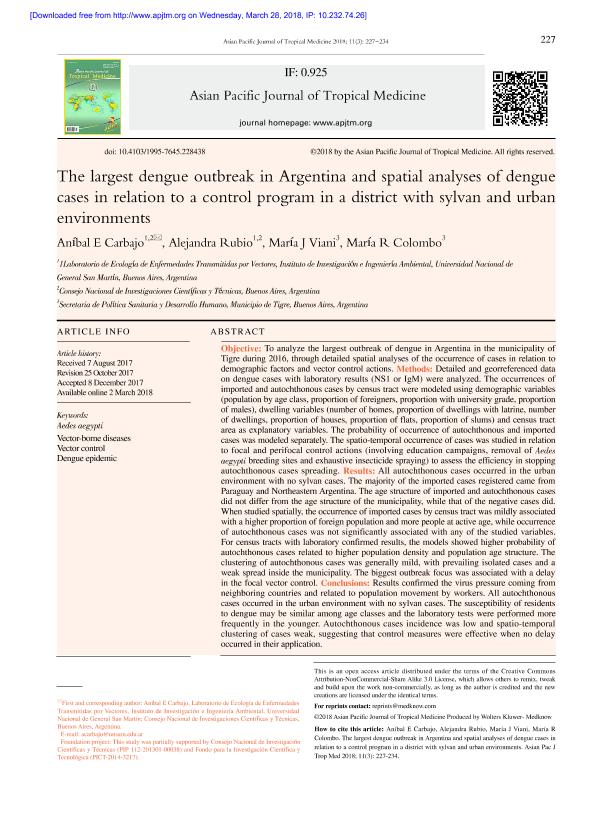Artículo
The largest dengue outbreak in Argentina and spatial analyses of dengue cases in relation to a control program in a district with sylvan and urban environments
Fecha de publicación:
04/2018
Editorial:
Hainan Medical College
Revista:
Asian Pacific Journal of Tropical Medicine
ISSN:
1995-7645
Idioma:
Inglés
Tipo de recurso:
Artículo publicado
Clasificación temática:
Resumen
Objective: To analyze the largest outbreak of dengue in Argentina in the municipality of Tigre during 2016, through detailed spatial analyses of the occurrence of cases in relation to demographic factors and vector control actions. Methods: Detailed and georreferenced data on dengue cases with laboratory results (NS1 or IgM) were analyzed. The occurrences of imported and autochthonous cases by census tract were modeled using demographic variables (population by age class, proportion of foreigners, proportion with university grade, proportion of males), dwelling variables (number of homes, proportion of dwellings with latrine, number of dwellings, proportion of houses, proportion of flats, proportion of slums) and census tract area as explanatory variables. The probability of occurrence of autochthonous and imported cases was modeled separately. The spatio-temporal occurrence of cases was studied in relation to focal and perifocal control actions (involving education campaigns, removal of Aedes aegypti breeding sites and exhaustive insecticide spraying) to assess the efficiency in stopping autochthonous cases spreading. Results: All autochthonous cases occurred in the urban environment with no sylvan cases. The majority of the imported cases registered came from Paraguay and Northeastern Argentina. The age structure of imported and autochthonous cases did not differ from the age structure of the municipality, while that of the negative cases did. When studied spatially, the occurrence of imported cases by census tract was mildly associated with a higher proportion of foreign population and more people at active age, while occurrence of autochthonous cases was not significantly associated with any of the studied variables. For census tracts with laboratory confirmed results, the models showed higher probability of autochthonous cases related to higher population density and population age structure. The clustering of autochthonous cases was generally mild, with prevailing isolated cases and a weak spread inside the municipality. The biggest outbreak focus was associated with a delay in the focal vector control. Conclusions: Results confirmed the virus pressure coming from neighboring countries and related to population movement by workers. All autochthonous cases occurred in the urban environment with no sylvan cases. The susceptibility of residents to dengue may be similar among age classes and the laboratory tests were performed more frequently in the younger. Autochthonous cases incidence was low and spatio-temporal clustering of cases weak, suggesting that control measures were effective when no delay occurred in their application.
Palabras clave:
AEDES AEGYPTI
,
DENGUE EPIDEMIC
,
VECTOR CONTROL
,
VECTOR-BORNE DISEASES
Archivos asociados
Licencia
Identificadores
Colecciones
Articulos(SEDE CENTRAL)
Articulos de SEDE CENTRAL
Articulos de SEDE CENTRAL
Citación
Carbajo, Anibal Eduardo; Rubio, Alejandra; Viani, María; Colombo, María; The largest dengue outbreak in Argentina and spatial analyses of dengue cases in relation to a control program in a district with sylvan and urban environments; Hainan Medical College; Asian Pacific Journal of Tropical Medicine; 11; 3; 4-2018; 227-234
Compartir
Altmétricas




